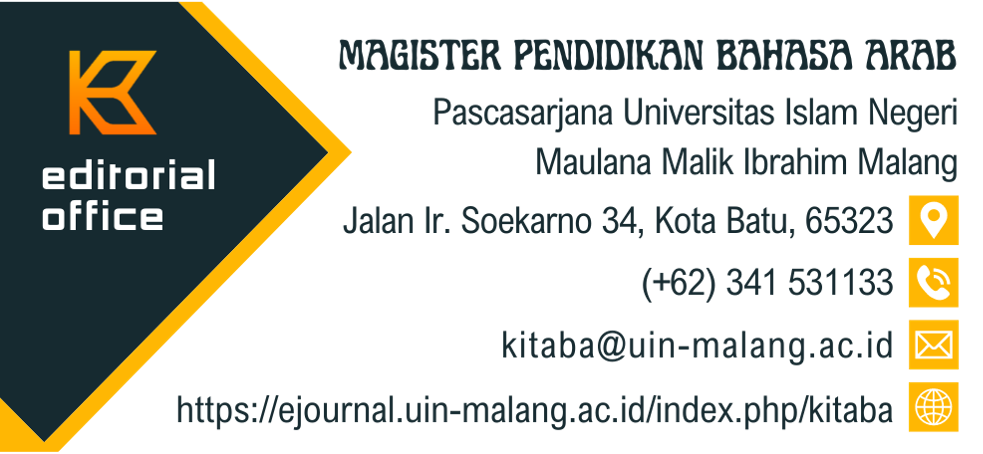REVITALIZING ARABIC VOCABULARY LEARNING THROUGH THE USE OF AUGMENTED REALITY MEDIA
Abstract
Full Text:
PDFReferences
Adawiyah, Y. R., Firdaus, S., & Istibsyaroh, I. (2022). PENGUATAN METODE MUBASYAROH TERHADAP PEMBELAJARAN KOSA KATA BAHASA ARAB DI LEMBAGA KELOMPOK STUDI KHUSUS (KSK) FATHIMATUZZAHRO’ PAITON PROBOLINGGO. لسـانـنـا (LISANUNA): Jurnal Ilmu Bahasa Arab Dan Pembelajarannya, 12(1), 118. https://doi.org/10.22373/ls.v12i1.13378
Al-Fauzan, A. R. I. (2011). Idha’at Li Mu’allim al-Lughah al-‘Arabiyah Li Ghairi al-Nathiqina Biha. Maktabah Al-Malik Fahd Al-Wathoniyah.
Amri, M. U., Sentryo, I., & Arisanti, W. O. L. (2023). PENERAPAN MODEL PEMBELAJARAN PROJECT BASED LEARNING (PjBL) DENGAN MENGGUNAKAN MEDIA AUGMENTED REALITY UNTUK MENINGKATKAN HASIL BELAJAR SISWA PADA MATERI BANGUN RUANG DI KELAS V SD. Jurnal Ilmiah Pembelajaran Sekolah Dasar, 5(1), 60–69. https://jipsd.uho.ac.id/index.php/journal/article/view/9
Anonim. (2013). Pentingnya Bahasa Arab di Era Globalisasi. https://elfaiznamjha.wordpress.com/201%0A3/09/17/pentingnya-bahasa-arab-di-eraglobalisasi/
Asmuki, A., & Muhammadiyah, A. (2020). PEMBELAJARAN BAHASA ARAB SEBAGAI DASAR PENGEMBANGAN KETERAMPILAN MEMBACA KITAB. Lahjah Arabiyah: Jurnal Bahasa Arab Dan Pendidikan Bahasa Arab, 1(1), 49–64. https://doi.org/10.35316/lahjah.v1i1.577
Azuma, R., Weon Lee, J., Jiang, B., Park, J., You, S., & Neumann, U. (1999). Tracking in unprepared environments for augmented reality systems. Computers & Graphics, 23(6), 787–793. https://doi.org/10.1016/S0097-8493(99)00104-1
Bungin, B. (2011). Penelitian Kualitatif. Kencana Predana Media Group.
Endarto, I. A., & Martadi, M. (2022). Analisis Potensi Implementasi Metaverse Pada Media Edukasi Interaktif. BARIK: Jurnal S1 Desain Komunikasi Visual, 4(1), 37–51. https://ejournal.unesa.ac.id/index.php/JDKV/article/view/48250
Fauzan, A., Muriyatmoko, D., & Utama, S. N. (2020). Penerapan Teknologi Augmented Reality pada Media Pembelajaran Bahasa Arab: Durus Al-Lughah Jilid 1. ELSE (Elementary School Education Journal) : Jurnal Pendidikan Dan Pembelajaran Sekolah Dasar, 4(1), 63. https://doi.org/10.30651/else.v4i1.4379
Hasan, M. H. (1988). Tadris al-Mufradat dalam Jurnal al-Muwajjih Edisi II. LIPIA.
Moleong, L. J. (2007). Metodologi Penelitian Kualitatif. PT Remaja Rosdakarya.
Mufidah, N., & Rohima, I. I. (2020). Pengajaran Kosa Kata Untuk Mahasiswa Kelas Intensif Bahasa Arab. Uniqbu Journal of Social Sciences (UJSS), 1(1). https://doi.org/https://doi.org/10.47323/ujss.v1i1.7
Nordin, F. N., Isa, A. A. M., Zakaria, M. Z., Yahya, H., & Nazmi, M. Z. M. (2022). AR-Learn Model: Model Pembinaan Aplikasi Pembelajaran berteraskan Augmented Reality (AR). JSASS: Sultan Alauddin Sulaiman Shah Journal, 9(1), 31–43. https://jsass.kuis.edu.my/index.php/jsass/article/view/186
Nugroho, A. (2005). Rational Rose Untuk Pemodelan Berorientasi Objek. Informatika.
Nurnaena, S., & Gumiandari, S. (2022). Efektivitas Penggunaan Augmented Reality Untuk Meningkatkan Penguasaan Kosa Kata Bahasa Arab dan Hasil Belajar Siswa di Sekolah MAN 1 Cirebon. Jurnal Edukasi Nonformal, 3(2). https://ummaspul.e-journal.id/JENFOL/article/view/4632
Rafif Wildan, M. (2023). Pengembangan Aplikasi Bergerak Berbasis Augmented Reality Untuk Orientasi Mahasiswa Baru Fakultas Teknologi Industri Universitas Islam Indonesia. Jurnal Multidisiplin Indonesia, 2(10), 3109–3122. https://doi.org/10.58344/jmi.v2i10.585
Sa’diyah, H., & Abdurahman, M. (2021). Pembelajaran Bahasa Arab di Indonesia: Penelitian Terhadap Motivasi Belajar Bahasa Asing. Lisanan Arabiya: Jurnal Pendidikan Bahasa Arab, 5(1), 51–69. https://doi.org/10.32699/liar.v5i1.1665
Setiawan, M. A. (2019). Pengembangan Materi Ajar Secara 3D Augmented Reality untuk Pengajaran Berbicara Bahasa Arab. Tarling: Journal of Language Education, 3(1). https://doi.org/https://doi.org/tarling.v3i1.3357
Sugiyono, S. (2008). Metode Penelitian Kualitatif, Kuantitatif dan R&D. Alfabeta.
Suryaningrat, E., & Rahman, B. A. (2020). Bimbingan Bahasa Arab Tingkat Dasar Pada Masyarakat di Kelurahan Dermayu Kabupaten Seluma Bengkulu. Manhaj: Jurnal Penelitian Dan Pengabdian Masyarakat, 9(1). https://ejournal.iainbengkulu.ac.id/index.php/manhaj
Syukran, S. (2018). Teori Budaya dan Pembelajaran Bahasa Arab bagi Masyarakat Aceh. An Nabighoh: Jurnal Pendidikan Dan Pembelajaran Bahasa Arab, 20(02), 162. https://doi.org/10.32332/an-nabighoh.v20i02.1276
Taufik, T., Azmi, D. I., Zahire, I. N. A., Sa’adah, N., Ernawati, N., & Wulandari, P. (2023). Pembelajaran Unsur-Unsur Bahasa Arab (Mufradat dan Qawaid) dengan Penerapan Strategi Pembelajaran Flashcard di Kelas V Madrasah Ibtidaiyah (MI). Diwan: Jurnal Bahasa Dan Sastra Arab, 15(1). https://doi.org/https://doi.org/10.15548/diwan.v15i1.1090
Utami, F. N., & Salamah, U. (2019). Augmented Reality Application of Hijaiyah Letters in Arabic Sign Language and Indonesian Sign Language (SIBI). Jurnal RESTI (Rekayasa Sistem Dan Teknologi Informasi), 3(1), 1–10. https://doi.org/10.29207/resti.v3i1.693
Vallino, J. R. (1998). Interactive Augmented Reality. University of Rochester.
Wijaya, M., Rozi, F., Nurus Suroiyah, E., & Wahyudi, W. (2023). Model Word Square : Konsep Simantik Siswa Mengenal Mufrodat pada Pembelajaran Bahasa Arab. PALAPA, 11(1), 207–220. https://doi.org/10.36088/palapa.v11i1.3122
Yang, S., & Mei, B. (2018). Understanding learners’ use of augmented reality in language learning: insights from a case study. Journal of Education for Teaching, 44(4), 511–513. https://doi.org/10.1080/02607476.2018.1450937
DOI: https://doi.org/10.18860/kitaba.v2i2.25451
Refbacks
- There are currently no refbacks.












